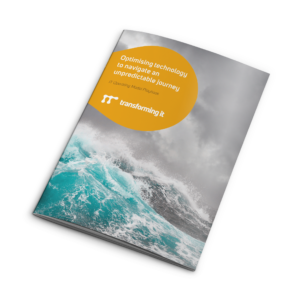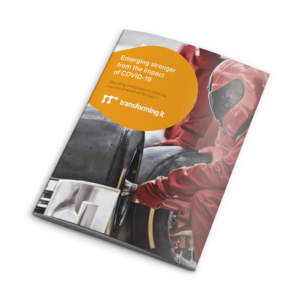This 3 part blog series unpacks the IT Operating Model playbook we created, first looking at the outline of what an IT Operating Model is and it’s value to your organisation, followed in part 2 by an introduction to the 4 cornerstones of implementation and why you would do it.
In the final part of the series, we share in more detail the approach to successfully undertaking IT Operating Model transformation and look to the future and how it will form the backbone of your growth.
Every 4 years, lone competitors set off from the coast of France on a 24,000 nautical mile yacht race
around the world – The Vendee Globe. Although the race route never changes, the conditions faced by the competitors are never same.
With the most unpredictable and extreme weather conditions to overcome, the route from the west coast of France, round the southern tip of Africa and on through the southern oceans under Australia and New Zealand to finally round Cape Horn and sail back up to the finish line in France requires both sailor and yacht to work in harmony, each aligned to the challenge and ready to push through the unknown.
Although a single person sails each yacht during the race, there are teams of experts who have worked tirelessly in the months and years leading up to the starting line, employing all their capability in a finely tuned approach to ensure the yachts will enable their skippers to follow the journey and achieve their goal.
“A Vendée Globe is like managing a business. There are schedules to respect, skills to develop, deliverables, logistics, accounting, a thousand things to prepare for and around the boat” David Sineau, Team Manager Initiatives-Coeur
It’s this tried and tested operating model approach that ensures the best chance once out at sea, providing the best available technology to battle hurricane force winds and sky-high waves. This, like many other sports, is a world in which the opportunity of technology is realized and prioritized in a better way than many “business” organisations…but it doesn’t have to be like that.
“A Vendée Globe is high technology, from the preparation to the little details, of course it is. But it is ultimately about the human side, it is about people putting their whole hearts and minds into their roles, and with these men and women on the team it means that the skipper leaves serene and confident.” Anne Le Cam, Team Yes We Cam
Importance of technology: No place for complacency
Having already made investments in technology to help bring improvements to different areas of your business, stakeholders will be operating with an understanding that IT systems are an essential enabler of growth and delivery, but too often this importance is forgotten or indirectly downplayed.
These investments may be relatively simple, or indeed in the more advanced, leading edge category, but however far you’ve dipped your toe in the technology water, full potential gains are often hampered by the disconnected way in which the systems and software are selected and implemented.
With a largescale move to subscription-based SaaS models, the less than perfect relationships between functional departments and your IT team are being circumnavigated, with functional heads going direct to vendors, using OpEx budget to fund licences and implementation.
The result? The selection of disjointed point solutions that aren’t making the most out of what could be a well-orchestrated, highly secure infrastructure that underpins an efficient eco-system with connected processes. A holistic, stable solution. This is where your optimised IT Operating Model comes in to play.

What is an IT Operating Model?: More than the technology
Operating Model:
The mode of working an organisation implements in order to maximise the value delivered by
its people and proposition.
An “IT Operating Model” is concerned with enabling the organisation to realise the greatest gains from its technology investments, with a secure and stable environment.
The outcome is not only the implementation and optimised use of technology to help maximise the performance delivered across an organisation, but also a method of working that by its very nature ensures continuous improvement, future planning and trust among stakeholders.
At the heart of success is the ability to build leaders and teams that have the capability to step away from old, restrictive modes of working and move to innovative, collaborative relationships that are clear on the need for a holistic approach to technology.
But undertaking this optimisation is no longer an option. Technology plays such a fundamental role in operations across all areas of business, that by not having a well-defined IT operating model which can keep pace with the demands of the volatile, uncertain and highly competitive marketplaces you operate in, many functions will fall short of the real potential they could deliver.
From the basics of failing to share data between departments, to wasted resources and weaknesses to cyber threats and data breaches caused by uncoordinated implementations of point solutions, your success is either negatively or positively impacted by the capability of your IT infrastructure to support the journey required by your goals.
Enable core activities with collective agreement: Positive relationships for positive outcomes
The yachts that take part in the Vendee perform so well in the harshest of conditions because every single element that goes into the design and build, including the technology, has been developed by experts in their own area with total understanding of how their contribution must align and contribute to the whole build.
With capability and authority established within your IT leadership and their function, they’re able to far more effectively deliver on the core activities that align your IT infrastructure to the delivery of strategic goals. They will now be able to successfully orchestrate technology investment decisions, manage partners and suppliers, and effectively support and enhance the value extracted by teams across the business.
Many organisations are only capable of delivering on one or two of these core activities and by failing to successfully address all, they are unable to realise the full value that can be achieved. This is because it’s not until you bring them all into play together that you’re able to remove the common barriers to optimised performance.
A significant blocker to getting this right is the belief that the technology itself is the answer, whereas in reality, the people involved (IT and other functions) and their collective understanding of how the overall strategy is enabled through technology selection, management and use in a holistic fashion, is the key. Success only comes when stakeholders work together effectively.
By having this approach, which is heavily weighted towards relationships and common goals, the process of IT infrastructure planning and technology selection can continue at pace without the traditional blockers – lack of trust, uncommon goals, individual agendas and egos.
In part 2 of this 3 part blog series we’ll give an introduction to the 4 cornerstones of implementation and the reasons why you would undertake this approach to change and growth.

